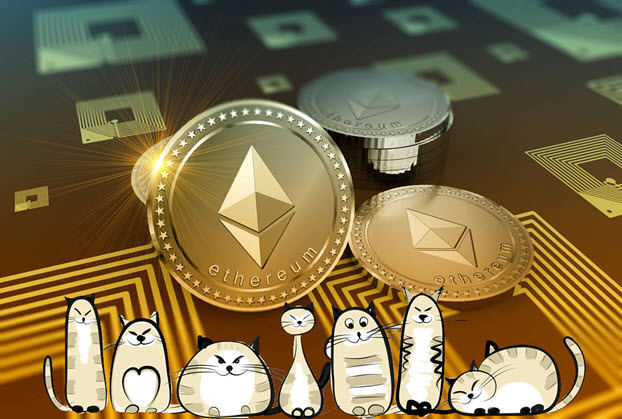
The CryptoKitties Craze, if there’s one thing the internet loves, it’s cats. So what happens when the unbridled affection for the furry little jerks many of us share our houses with meets the world of cryptocurrency? CryptoKitties, that’s what.
Crypto-What?
CryptoKitties are digital pets. These cartoonish little cats, as created by the CryptoKitties art team, have unique physical attributes when you look at them. Any number of combinations of color and pattern are generated randomly when a CryptoKitty is “born” in order to create a cat with a unique look to its fur, eyes, whiskers, and other details. That look is almost always comically grotesque, with the algorithm routinely generating cats with crossed eyes, snaggled teeth, and bizarre expressions.
Similar to the pet rock, the analog version of the novelty “pet” popularized in the 1970s, CryptoKitties don’t really do anything – they just sit there on your computer screen. Yet because there are so many different variations to each CryptoKitty, cats with rare traits have quickly become collectible in nature, with collectors willing to buy, sell, and trade them like baseball cards, comic books, Beanie Babies, or any other rare item. Not only that, but CryptoKitties have become so collectible that there are some that have sold for more than $100,000 at auction.
As Real as They Need to Be
“But that’s insane!” You might say. “Why have people gone so crazy about these things? They’re not even real!” On the one hand, that’s true. You can’t scoop up and cuddle your bucktoothed, mohawked, googly-eyed green-and-purple furred CryptoKitty in real life – you can only look at a goofy cartoon image of it on your computer screen. So what has collecting CryptoKitties grown so wildly popular? It comes down to one thing: money, of course.
The CryptoKitties code – the programming that controls how these digital critters are randomly generated – was built on the Ethereum blockchain. In order to buy, sell, or trade a CryptoKitty, you need to do so using Ether, the cryptographic token that makes Ethereum run – and as a result, owning a CryptoKitty has become a digital investment. You can buy a CryptoKitty for a specific amount of Ether, hold on to it for a while, and then sell it at a profit to someone else. Whoever bought that $100,000 CryptoKitty is likely to try to flip it for even more money down the road.
Clogging the Internet With Fake Cats
So there’s no denying that the CryptoKitties fad has gripped the internet, much in the same way that Pokémon, Tamagotchi, Neopets, and every other digital collectible game out there. The fact that each CryptoKitty holds value for a specific amount of Ether makes them even more popular. The problem, though, is that these kitties have been multiplying like rabbits to the point where their burgeoning numbers are actually slowing down the Ethereum blockchain for people looking to conduct the “legitimate” business of not trading digital cats.
There are two things of import here. Firstly, and this is as bizarre as it is true: there are so many CryptoKitty transactions going on that Ethereum as a whole has begun to ground to a halt from the sheer volume of those transactions. This is undoubtedly frustrating for anyone trying to use the blockchain for less frivolous matters, like designing DApps or smart contracts that don’t involve creating fake cats. Secondly, you read that right: not only can you collect and trade CryptoKitties, you can also breed them. The problem is that this also requires the use of the Ethereum blockchain – each new cat is generated by a smart contract – so not only are CryptoKitty collectors slowing down the network with the number of digital cats changing hands, they’re adding to it with each new “litter.”
CryptoKitty Animal Husbandry
CryptoKitties enables enthusiasts to reach new and ever-higher levels of obsession, thanks to the ability to breed the digital cats you own in order to create new ones. You can breed any two cats together that you like – you get to assign which one acts as the “sire” for the mating and which one acts as the “dame” – and the CryptoKitties get down to business. Soon, a new, unique cat is generated by combining the 256-bit “DNA” of one cat with the DNA of the other. Once your new cat is born, it will have then “inherited” traits, randomly, from both of its parents.
This breeding feature has done nothing but supercharge the demand for CryptoKitties. Two wildly popular and expensive CryptoKitties can mate and create a third, which might possibly come to be even more valued than its parents; the cost of birthing a new Crypto Kitty is currently 0.015 Ether – roughly equivalent to around $18.50 at the time of this writing. This means that a newborn CryptoKitty has a high probability of turning a profit for the owner, especially if it’s from a valuable pedigree.
Becoming the Digital Crazy Cat Lady You Always Wanted to Be
Does the idea of buying and breeding weirdo cartoon cats appeal to you? Do you have more money than you know what to do with? Are you convinced you can make a living by selling digital kittens to other weirdos? Luckily, the barrier to entry to becoming a CryptoKitty owner is set quite low. Unlike many other cryptocurrency-based projects, the company behind CryptoKitties – Canada-based AxiomZen – made access to this world of blockchain-based digital cat breeding highly accessible. Instead of throwing you to the wolves, AxiomZen walks each new user through the process needed to start their journey.
Users can register at the CryptoKitties website for free. Part of the process involves downloading MetaMask, a browser extension that makes learning how to transact using cryptocurrency coins online easy as it acts as a digital wallet for Ether, the currency used to buy and breed CryptoKitties. There’s no other way to participate – you can’t buy a CryptoKitty with a fiat currency like the US dollar – but the site provides clear instructions on how to purchase Ether from an exchange and transfer it to your MetaMask wallet. Once you’ve got a balance, you can select cats for sale on the CryptoKitties Marketplace, the built-in eBay-like auction house for trading CryptoKitties. From there, it’s off to the races.
This Cat-Scratch Fever May Not Burn Itself Out
CryptoKitties has undergone a meteoric rise since its inception in November of 2017. The fever for digital cartoon cats so ugly they’re cute shows no signs of abating any time soon. CryptoKitties might not be the “killer DApp” of the blockchain world, but it’s certainly representative of the kind of lucrative (and globe-spanning) gleeful silliness that cryptocurrency can create.










Cryptokitties, Cryptodogs, Cryptorocks so the name goes onnn. Ha ha ha looks very funny
Interesting subject..enjoyed reading it.